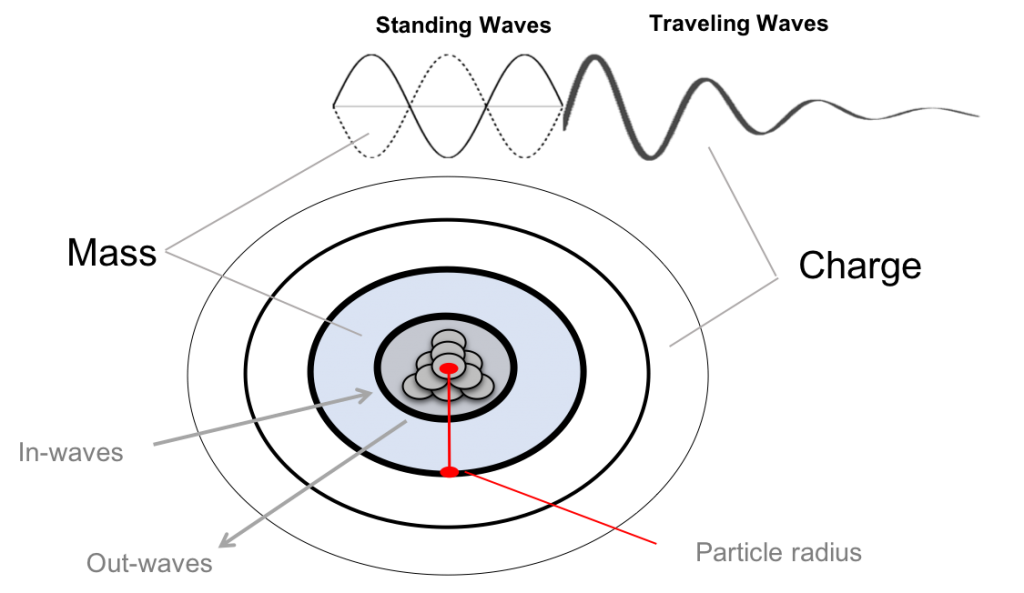New Theory or Model
Energy Wave Theory
Author Jeff Yee
Premise Particles, photons and their motion are unified and explained by waves
Mind Blown Particles and forces are simplified to 5 constants using classical equations
Type Aether
Homepage http://www.energywavetheory.com
The strange quantum world can be explained and unified with classical physics under a theory based on waves that travel the universe – known as energy wave theory (EWT). The EWT mathematical model describes the simplicity of nature. One fundamental particle that forms all particles. One principle cause of all forces. Three spatial dimensions.
Basic Concepts of EWT
- Particles are formed from a fundamental particle which is calculated to be near the rest energy of the neutrino. The reflection of traveling, longitudinal waves (electric force) creates standing waves of stored energy for a radius that is proportional to wave amplitude. A combination of the fundamental particle creates standing waves of larger amplitude and radius, creating the appearance of new particles, whose stability depends on the geometry of the formation of such fundamental particles. It causes the creation/oscillation of new particles and decay. Only certain geometries, like the electron, are stable for long periods in nature.

- The geometry of particle formation is replicated throughout nature because of a requirement for the fundamental particle to be stable where wave amplitude is minimized (the principal cause of all forces). It forces geometries where particles are stable at wavelengths, particularly in triangular and tetrahedral patterns. The fundamental particle is the building block in this geometry from particles to molecules.

- The principle cause of motion is for a particle to minimize wave amplitude. The unification of forces (electric, magnetic, strong and gravitational) is possible when the variables are reduced to a common component — wave amplitude at a measured distance. Particle mass (used in Newton’s laws of motion and gravitation) is simplified to standing wave energy, measured as wave amplitude. Particle charge (used in Coulomb’s law) is also simplified to wave amplitude as a measurement of traveling, longitudinal waves. It is described below where waves spread spherically from the particle’s center point, decreasing in longitudinal wave amplitude (signified by thickness of lines).

- Mathematically, the equations for energies and forces can be simplified to four universal constants, and one constant that is the property of the electron: 1) wave speed (speed of light), 2) longitudinal wave amplitude, 3) longitudinal wavelength, 4) density, and 5) electron wave center count. These constants and the equations that they are used in can be found at: http://energywavetheory.com/equations/
Proof
A complete list with proof of equations matching existing experimental data is available at:
http://energywavetheory.com/introduction/wave-theory-of-everything/.
A short summary is as follows:
- Calculated particle energies from the smallest neutrino to the large Higgs boson and found a linear relationship when based on a fundamental particle (a combination of this particle to the 4th power).
- Unified the energies for particles and photons into a single wave equation, explaining the difference as wave form (standing, longitudinal waves for particles; transverse waves for photons).
- Unified the electric, magnetic, gravitational and strong forces based on the electron energy at distance, as different wave forms or a change in wave amplitude. Calculations are validated against Coulomb’s law for the electric force, Distinti’s New Magnetism for the magnetic force, Newton’s law of universal gravitation for gravity and experimental results for the strong force.
- Derived 23 fundamental physical constants used in modern physics with 5 wave constants.
Additional information is available at: http://www.energywavetheory.com
![]()

